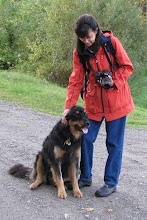As I approached a beetle perched atop a flower stalk, I
noticed a large number of mites crawling all over it. Amazingly, the next day in a different
location, I found the dead body of a vole with the same type of beetle
burrowing under the carcass. It had
several mites on it as well.
After searching for an identification of the insect, I
learned more about this very interesting beetle and its relationship with the
mites.
Here is a short summary of the beetle’s behavior and the
mites’ role in helping its young survive.
Beetles:
The beetle is the Gold-necked Carrion Beetle, Nicrophorus
tomentosus, who has sensitive antennae that contain olfactory organs that help
it find carrion over long distances.
Once the body is found, the male and female beetles manipulate
the carcass in various ways and then the female lays her eggs. The young eat directly from the carcass or eat
regurgitated food from both parents. The
parents are attentive to the young and protect them from competitors while they
feed. The female only leaves the young once they are fully developed. If the female dies, then the male takes over
that role.
Mites:
Another fascinating fact:
the mites normally cling to the beetle’s underside but when the beetle
is about to fly, they all climb up on its back, facing forward. They are protected in this position because
the beetle rotates its forewing coverings (elytra) up and toward the center,
forming a tent-like enclosure with the mites inside.
Reference sites:





